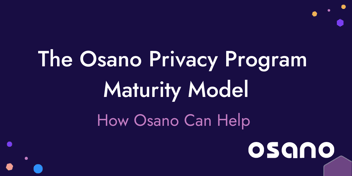
How Osano Can Help
How Osano Can Help You Mature Your Privacy Program Building, running,...
Read NowGet an overview of the simple, all-in-one data privacy platform
Manage consent for data privacy laws in 50+ countries
Streamline and automate the DSAR workflow
Efficiently manage assessment workflows using custom or pre-built templates
Streamline consent, utilize non-cookie data, and enhance customer trust
Automate and visualize data store discovery and classification
Ensure your customers’ data is in good hands
Key Features & Integrations
Discover how Osano supports CPRA compliance
Learn about the CCPA and how Osano can help
Achieve compliance with one of the world’s most comprehensive data privacy laws
Key resources on all things data privacy
Expert insights on all things privacy
Key resources to further your data privacy education
Meet some of the 5,000+ leaders using Osano to transform their privacy programs
A guide to data privacy in the U.S.
What's the latest from Osano?
Data privacy is complex but you're not alone
Join our weekly newsletter with over 35,000 subscribers
Global experts share insights and compelling personal stories about the critical importance of data privacy
Osano CEO, Arlo Gilbert, covers the history of data privacy and how companies can start a privacy program
Upcoming webinars and in-person events designed for privacy professionals
The Osano story
Become an Osanian and help us build the future of privacy!
We’re eager to hear from you
Benchmark and Grow Your Organization’s Privacy Program
Data privacy program management involves the overall strategy, planning, implementation, and continuous improvement of an organization’s data privacy program. Taken together, the individual elements described in this model serve as a good approximation of a data privacy program, but the whole of a privacy program is more than just the sum of its parts. This element represents the holistic, end-to-end management of a data privacy program, inclusive of the elements described in this model and of any other elements unique to your organization. This includes the coordination of the different components and activities that make up the program, as well as the allocation of resources and the management of stakeholders.
An immature data privacy program management process is characterized by ad hoc, reactive, and disjointed efforts to address privacy risks and compliance requirements. The organization may lack clear ownership and accountability for the program, as well as a comprehensive and cohesive privacy strategy. The program may also be under-resourced, poorly documented, and not regularly evaluated or updated. You may pursue individual activities (such as those described in this model) but struggle to prioritize one over the other or find that as you progress in one area of data privacy, another area suffers.
In contrast, a mature data privacy program management process is characterized by a proactive and strategic approach to privacy risk management and compliance. The program is well-defined, well documented, and regularly evaluated and updated. There is clear ownership and accountability for the program, with dedicated privacy professionals or teams leading the effort. The program is supported by sufficient resources, including personnel, technology, and funding, and has the buy-in and participation of all relevant stakeholders. You’ll have identified priorities and established a systematic approach to growing and maturing your privacy program, and you will track its growth over time.
To improve your overall privacy program management, privacy professionals can take several actions, including:
With Osano, building, managing, and scaling your privacy program becomes simple. Schedule a demo or try a free 30-day trial today.